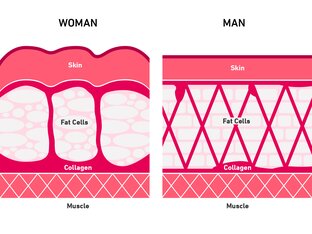Dents on thighs and bottom? We all know the feeling! Although they are harmless to your health and completely normal, they can really put you off looking in the mirror. Find out what's behind them and how you can effectively strengthen your connective tissue.
What is connective tissue?
Connective tissue occurs in different forms throughout the body and ensures that the body retains its shape. It is the connective tissue that holds everything together.
It can be imagined as a gelatinous substance in which individual cells are embedded. The basic substance described consists of certain proteins and a lot of water. Collagens make up a large proportion of these proteins. The task of the connective tissue cells is to produce these proteins. In addition to the so-called loose connective tissue found between organs, there is also tight connective tissue in which the collagen fibres are bundled together in thick bundles. It forms the tendons and ligaments.
What does connective tissue have to do with cellulite?
Just below the outer layer of skin is connective tissue. It is permeated with fibrous proteins, primarily collagen. These collagen strands connect the outer layer of skin with the deeper layers and simultaneously give it firmness and elasticity. If the connective tissue architecture changes, small gaps form and fatty tissue can push its way up from below to the surface of the skin, so to speak. Dents form.


Why do women have weaker connective tissue than men?
Up to 85% of women develop skin that is prone to small dents after puberty. Men are largely spared from this. But why is that so?
This has something to do with the alignment of the connective tissue fibres in the skin. While they are usually arranged vertically in women, men have a criss-cross pattern that prevents the fat cells from ‘pushing through’ to the surface as described above.
Incidentally, women who are spared from cellulite also have more of these criss-crossed strands, so that the connective tissue is generally stronger. In men, the connective tissue fibres also appear to be more stable, while in women they break more easily.
Strengthening loose connective tissue from the inside
Nutrition
A balanced diet is an important factor when it comes to firm connective tissue. In principle, if you are overweight, you should aim for a moderate calorie deficit to reduce excess fat. This means consuming fewer calories than you need.
If you want to reduce your cellulite, you should avoid foods that contain sugar and white flour products. These seem to have a particular influence on the texture of the skin.
At the same time, you should eat a diet that is rich in micronutrients to ensure that your body is getting all the essential vitamins, minerals and other nutrients it needs. In particular, you should make sure you are getting enough vitamin C. This is because vitamin C plays a role in the body's own collagen production. And, as you have already learned above, this fibre protein is particularly important for strong connective tissue.
Manganese and copper also help to produce collagen and thus contribute significantly to healthy connective tissue. You can find the trace element copper in nuts and green vegetables, for example. Foods rich in manganese also include green vegetables and oats.
With dietary supplements
You may have heard that collagen supplements help with wrinkles. But did you also know that they can help anyone with weak connective tissue? A 2015 study provides scientific proof of this. Consistent use of a dietary supplement with collagen peptides over several months can significantly reduce the appearance of unwanted wrinkles. No wonder, because collagen is one of the most important supporting proteins in connective tissue. It ensures firmness and elasticity at the same time.
Manganese and copper also play an important role. You can find these trace elements in good quantities in combination preparations. A high-dose mono-preparation should only be used if necessary, after a blood analysis.
6 tips for strengthening loose connective tissue
There are various reasons for loose connective tissue, which is why it makes sense to combine different treatment approaches. Even if each cellulite home remedy only brings small results in itself: the effects add up if you keep at it!
1. Massage & lymphatic drainage
Various massage techniques and lymphatic drainage can help with cellulite. They stimulate blood flow to the affected areas, ensuring that nutrients are efficiently delivered there. At the same time, excess water is removed.
2. Alternating hot and cold showers & cold
Cold temperatures can also stimulate blood flow! You can try the traditional hot-and-cold shower routine at home or consider cryotherapy in a cold chamber.
3. Cremes & Seren
Certain creams can help with cellulite. In particular, retinoids and caffeine have been investigated as ingredients for the treatment of cellulite. Some plant substances are also interesting, for example those found in horse chestnut.
4. Nutrition & Drinking
What you eat has a significant influence on your connective tissue! Make sure you eat a balanced diet and plan to drink at least 1.5 litres a day. It's best to have a carafe of water or a teapot ready and waiting in the morning!
5. Fascia training
You can massage the relevant parts of the body with a fascia roll to stimulate blood flow.
6. Regular exercise
Put on your trainers and get ready to fight cellulite! It doesn't have to be a marathon; walks and a few strengthening exercises are a good start. The important thing, as with all other measures, is regularity.
Conclusion
Experts advise: attack your connective tissue from all sides! A combination of a healthy lifestyle, creams, massages and supplements ensures maximum effect. This is how you strengthen your tissue holistically and increase the chance of visible results.
FAQs
Connective tissue can be strengthened by a combination of massage, creams, sufficient fluids, a balanced diet and exercise. Particularly effective are collagen supplements and vitamin C, which support collagen production and strengthen tissue.
If you want to strengthen the connective tissue on your stomach, you can massage this area and apply special creams to it. In addition, it makes sense to take measures that support the connective tissue throughout the body: collagen and vitamin C supplements, a balanced diet, sufficient fluids and some exercise.
Foods with sufficient proteins and a high vegetable content. In particular, varieties rich in vitamin C, such as peppers and tomatoes, should be on the menu. Citrus fruits also contain a good amount of this vitamin.
References
https://viamedici.thieme.de/lernmodul/546164/530375/bindegewebe+und+bindegewebezellen, accessed on 16 January 2025
https://www.dge.de/wissenschaft/referenzwerte/kupfer-mangan-chrom-molybdaen/#:~:text=Kupfer%20ist%20Bestandteil%20von%20Enzymen,Haferflocken%20und%20Tee%20zu%20 accessed on 17.01.2025
Castellanos-García, I. et al. 2024. Cellulite & Skin Tightening: A Review of Pathophysiology and Topical Treatment. Dermatol. Rev. Dec 2024 https://pubmed.ncbi.nlm.nih.gov/32976174/
Bayrakci Tunay, V. et al. 2010. Effects of mechanical massage, manual lymphatic drainage and connective tissue manipulation techniques on fat mass in women with cellulite. J Eur Acad Dermatol Venereol. 2010 Feb;24(2):138-42. https://pubmed.ncbi.nlm.nih.gov/19627407/
Schunck, M. et al. 2015. Dietary Supplementation with Specific Collagen Peptides Has a Body Mass Index-Dependent Beneficial Effect on Cellulite Morphology. J Med Food. 2015 Dec;18(12):1340-8. https://pmc.ncbi.nlm.nih.gov/articles/PMC4685482/









